System-on-Chip MediaTek Helio P10
After the company MediaTek introduced its top-end product - Helio X20 , which became the first mobile system-on-a-chip with ten processing cores in three clusters, in June of the same year another model of the mobile processor was announced - Helio P10 . This is a high-performance mid-range on-chip system designed for the highly popular segment of smartphones with characteristics above average.

The market segment targeted by the Helio P10 chip is much more massive compared to the high-budget solutions for which the Helio X20 was designed. If the X series is the top one for MediaTek, and provides the maximum performance and functionality corresponding to the upper price segment, the P series is also quite productive, but optimized to minimize the form factor and low power consumption, which allows you to produce thin smartphones with a capacious battery and good indicators of functionality and performance.
Such an energy-efficient solution allows you to provide longer smartphone life without recharging - for example, compared with the previous generation MT6752 system-on-chip, an average of 12% increase in operating time on a single charge is provided. And also reduces the likelihood of problems associated with overheating, but it becomes possible to use very thin cases for such smartphones, which is quite popular with manufacturers.
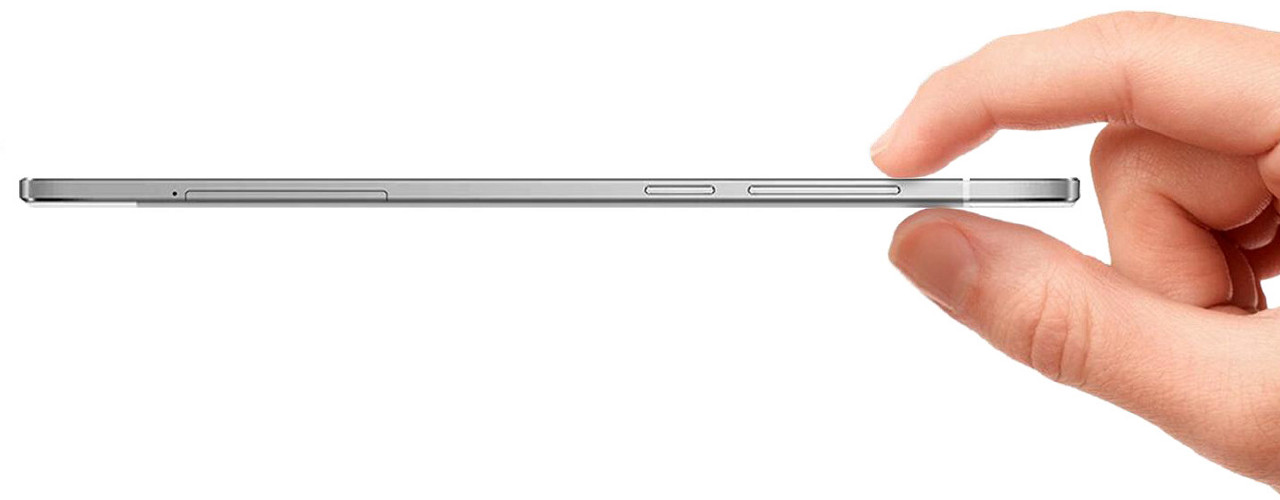
In addition, not all users want to pay the maximum price for a top-end smartphone, the capabilities of which they simply will not use. 10 computing cores in Helio X20 is very good, but not everyone needs it, the majority of users need 4-8 cores. The new Helio P10 chip just contains eight 64-bit ARM Cortex-A53 cores, which is quite logical for the solution of the upper-middle level. Moreover, these CPU cores operate at a frequency of 2 GHz , which ensures the maximum computational speed among solutions in this segment.
A top-end graphics core in a mass product is also not necessary at all, but the GPU must still be powerful enough, which is especially important now, when some of the calculations are beginning to be shifted, including to it. The new MediaTek system-on-chip uses the new ARM Mali-T860 video core operating at a frequency of 700 MHz, which in its functionality and performance is excellent for the mid-price range.
If we talk about specific numbers, then, compared to the system-on-chip MT6752, the use of the new GPU gives a performance increase of 20% while reducing the graphics core by 30%. The same applies to other tasks, including multimedia and related to the direct purpose of the smartphone - work with cellular networks. In general, the Helio P10 modem part provides about 20% less power consumption, and multimedia processing takes place with a quarter less power consumption. All this translates into longer battery life - one of the most important parameters for smartphones.
But even more important than the numerical characteristics are those technologies that really improve the comfort and functionality of smartphones for users. An example is support for the widest possible list of mobile communication standards, including advanced support for high-speed LTE networks. Or complex post-processing of images obtained using smartphone cameras, which can significantly improve the quality of images. This is already important for absolutely all users and is an indisputable advantage, even more important than the number of cores.
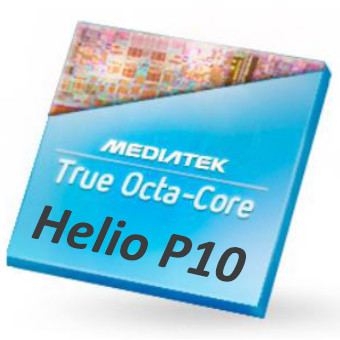 Helio P10 is the first system-on-a-chip from the new Helio P line, which differs in that it combines a mid-range price and some characteristics of top-end solutions: high-speed data transfer on mobile networks, high quality sound and image. The Helio P10 model contains an integrated modem part that supports all the main LTE frequency ranges, LTE category 6 standard , carrier frequency aggregation according to the 2x20 MHz scheme, as well as data transfer rates up to 300/50 Mbit / s.
Helio P10 is the first system-on-a-chip from the new Helio P line, which differs in that it combines a mid-range price and some characteristics of top-end solutions: high-speed data transfer on mobile networks, high quality sound and image. The Helio P10 model contains an integrated modem part that supports all the main LTE frequency ranges, LTE category 6 standard , carrier frequency aggregation according to the 2x20 MHz scheme, as well as data transfer rates up to 300/50 Mbit / s.
Like the older MediaTek chip-based systems, the P10 uses a load-sharing algorithm for the CorePilot computing cores, which allows you to use the capabilities of a heterogeneous architecture, distributing tasks among suitable computing units: universal CPU cores, a graphics core, or both at the same time.
The Helio P10 chip-based system also has rich multimedia capabilities, providing support for single 21-megapixel cameras or two 16-megapixel and 8-megapixel cameras, all with advanced demosaicing (debayerization) and noise reduction algorithms, improved shooting in low lighting, continuous focusing, support for HDR video and a short delay between shots, adaptive image quality improvement technology MiraVision, etc.
Helio P10 also features support for truly high-quality audio output with a declared signal-to-noise ratio of 110 dB and a non-linear distortion coefficient of 95 dB, which not every mobile solution can boast of, but extremely expensive smartphones from well-known companies: Apple, Samsung, Sony and others .
In general, it is safe to say that the Helio P10 brings some of the features of the high-end X series to mass products. Speaking conditionally, the new product differs from the previous mass MT6752 chip by an improved modem and a new graphics core, as well as reduced power consumption. And from the characteristics of the top X series, the new chip has computing cores operating at a frequency of 2 GHz, support for two high-resolution cameras with advanced post-processing, as well as the highest sound quality.
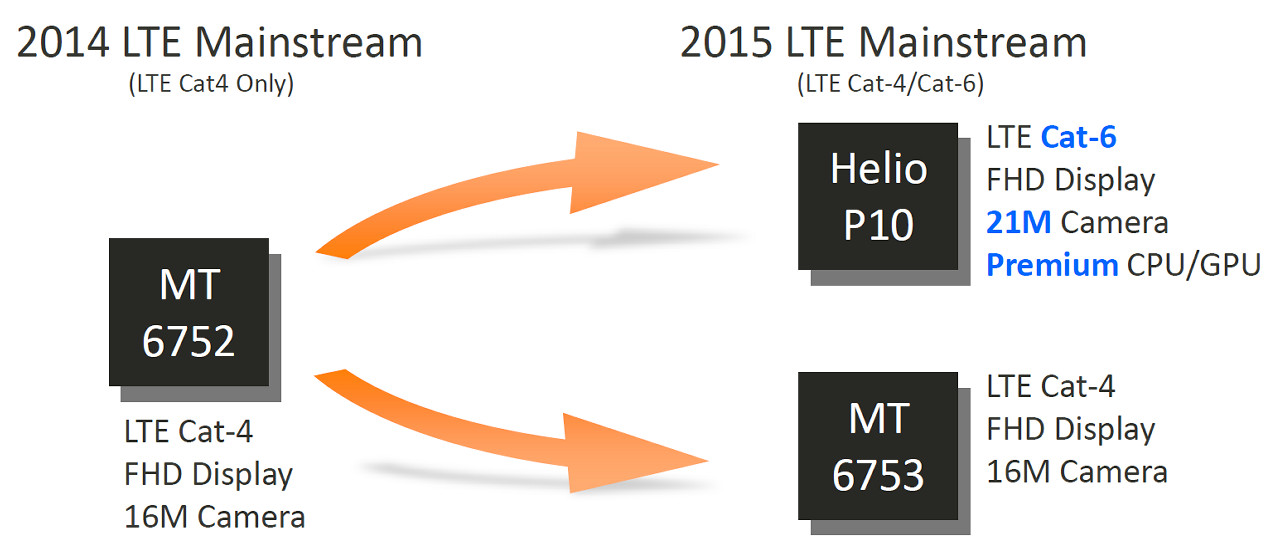
At the moment, the mass series of MediaTek is as if divided into two branches: advanced and inexpensive. If the MT6753 system-on-chip is a slightly improved MT6752 chip with support for Category 4 LTE networks, FullHD displays and a 16-megapixel camera, then Helio P10 already has more powerful CPUs and GPUs, 21-megapixel cameras and LTE mobile networks Category 6, with carrier aggregation and a maximum data transfer rate of 300 Mbps.
The most interesting thing is that with all this, the Helio P10 system-on-chip provides even slightly lower power consumption compared to the MT6752 chip of the same positioning from the previous generation!

As you can see from the numbers in the table, in the disconnected networks (Flight Mode), the new system-on-chip consumes 5% less energy, and when displaying the home screen and in the absence of active tasks, it is already 33%, which is quite a lot. Unfortunately, the table does not show individual figures for improving energy consumption in different tasks, but the average improvement in the energy consumption parameter is 25% for the modem part and 25-30% when processing multimedia data, including encoding and decoding of audio and video streams, as well as simple 2D games.
In order to understand how big a jump in functionality and performance MediaTek has made with the release of the new system-on-chip, let's first look at the most important characteristics of the new chip and compare them first with the previous solution in the form of the popular MT6752 model:

As you can see, for The chip manufacturing process also uses the 28 nm process technology at the factories of the Taiwanese company TSMC, a semiconductor chip manufacturer. But the 28HPM process for Helio P10 is incorrectly indicated in the table, this chip is the first product of the company, which uses 28HPC + technology to reduce energy consumption.
TSMC claims to be able to get up to 15% more performance at the same level of consumption and a 30-50% reduction in leakage compared to 28HPC. Thanks to the use of an improved process technology, as well as architectural optimizations, the Helio P10 system-on-chip consumes up to 30% less energy compared to previous chips manufactured using the 28HPC technology.
As universal computing cores in Helio P10, the same eight Cortex-A53 cores are used as in MT6752, but they already operate at a frequency of 2.0 GHz, and not 1.7 GHz - this is another achievement of a more advanced technical process. The memory bandwidth was also improved - the operation of one channel of LPDDR3 memory with a capacity of up to 4 GB at a frequency of 933 MHz against 800 MHz and 3 GB, respectively, is supported.
In place of the ARM Mali-T760 MP2 graphics core operating at a frequency of 700 MHz, an improved ARM Mali-T860 MP2 video core with the same frequency characteristics came. The Mali-T860 can scale up to 16 cores, but in this case two cores contain four ALU execution units. So in terms of configuration, this GPU is identical to the Mali-T760, but it received several architectural improvements, which allowed to achieve some increase in performance compared to the previous solution.
The multimedia features of the new items have also been improved. Helio P10 has added support for 21-megapixel cameras with a processing frequency of 24 FPS in addition to supporting 16-megapixel cameras operating at 30 FPS. But even more important can be called the appearance of improved algorithms for hardware-based image processing: demosaics (debayerization), noise reduction systems and adaptive sharpening, which we will consider in more detail below.
The functionality of the new system-on-chip in terms of encoding and decoding video data has not changed; decoding of H.264 and H.265 video formats in 1080p resolution at a frame rate of 30 FPS is supported, as well as encoding to H.264 format with the same characteristics. But, thanks to architectural changes, in these tasks a reduction in energy consumption by a quarter was achieved. You can also highlight support for displaying information on displays with a resolution of 1920x1080 pixels and 12 layers of Blending Layer against 8 layers.
One of the most tangible improvements in the Helio P10 is the completely new modem part, supporting Category 6 LTE networks with carrier aggregation and a maximum data transfer rate of 300/50 Mbit / s versus just 4 category with 150/50 Mbit / s. The new chip also introduced support for CDMA2000 1x / EVDO Rev. networks. A (3.1 / 1.8Mbps, SRLTE), corresponding changes were made in the radio part.
Among other improvements, we note the support of data transmission over wireless networks of Wi-Fi standards 802.11 a / b / g / n with a transfer rate of up to 90 Mbps compared to the maximum speed of 78 Mbps of the previous model of the system-on-chip. Support for the operation of GPS, Glonass and Beidou global positioning systems has also been improved - in particular, the time to first fix (TTFF - Time To First Fix) has been reduced.
And what about competitors? Comparison with the previous system-on-chip from MediaTek is interesting, but the rest of the industry does not stand still, and the same company Qualcomm has released several solutions for the same market segment. Let's compare the Helio P10 with competing solutions: Snapdragon 425 (MSM8952) and Snapdragon 615 (MSM8939).

Firstly, Helio P10 is immediately distinguished by 28HPC + process technology (28HPM is again mistakenly indicated) against 28LP for Qualcomm system-on-chip. The advanced TSMC workflow allows for higher CPU and GPU frequencies, and hence their performance. Actually, this is also evident from the table - all three solutions have eight Cortex-A53 cores, but in the MediaTek system-on-chip they operate at a frequency of 2.0 GHz versus 1.5-1.7 GHz in the case of Snapdragon.
The same goes for GPUs. If the Adreno 405 video core as a part of the Snapdragon pair operates at a frequency of only 550 MHz, then the Helio P10 graphics in the form of a dual-core ARM Mali-T860 MP2 differ in operation at a higher frequency of 700 MHz. Of course, frequency is not the only indicator of GPU performance, but it is very important. And along with ARM architectural improvements in the new GPU core, it is MediaTek's solution that should provide the best speed.
Other distinguishing characteristics of the SoC under consideration include support for one camera with a resolution of up to 21 megapixels, albeit at a frequency of 24 FPS, versus 16 megapixels at 30 FPS. In addition, Helio P10 has a more powerful dual signal processor (ISP) that provides signal processing from a pair of cameras: 16 MP and 8 MP, in contrast to the dual ISP with support for two 8-megapixel cameras or even a single ISP in the case of Snapdragon 615.
The video output engine in P10 supports displays with a resolution of 1920x1080 pixels at 60 frames per second and 12 layers of mixing versus 4 layers from competitors. MediaTek considers it to be a very important advantage to support high-quality sound output with a signal to noise ratio of 110 dB and a non-linear distortion coefficient of 95 dB, in contrast to the signal-to-noise ratio of 96 dB in the case of integrated DACs in the integrated power management circuit (PMIC) for competing models Snapdragon
The remaining parameters for mass solutions from MediaTek and Qualcomm are approximately the same, and market success will depend on price and other characteristics, such as energy-efficiency systems-on-a-chip and third-party support for proprietary technologies of these companies. Well, since MediaTek's products are traditionally characterized by relatively low prices, the Helio P10 system-on-chip has every chance of gaining a considerable market share, and not only among Chinese smartphone manufacturers.
We noted above that the work with cameras in the new Helio P10 system-on-chip has been improved, and now we will dwell on this in more detail. Firstly, the chip includes two powerful digital signal processing (ISP) processors that support sensors with resolutions up to 16 and 8 megapixels for the main and front cameras, respectively. The read and processing speed for the main camera can be 24 FPS for 21-megapixel sensors and 30 FPS for 16-megapixel.
Information from the main camera is processed by the TrueBright ISP signal processorthat supports highly sensitive sensors with an RWWB filter (Red, White, White, Blue - red, white, blue), and not just traditional RGBW. Such a color filter, in which the green pixel is replaced by white, helps to increase photosensitivity and improve the final quality of images. In the case of applying such a solution, the sensor will capture twice as much information about the light, and the detail and color information will remain the same.
At the same time, the so-called zero shutter delay ( Zero-Shutter Delay), due to which there will be practically no pauses between images. MediaTek’s state-of-the-art chip-based systems provide minimal latency - the pause between consecutive shots is less than 200 ms. There is also support for continuous autofocus, updated every frame, as well as support for laser and phase detection autofocus.
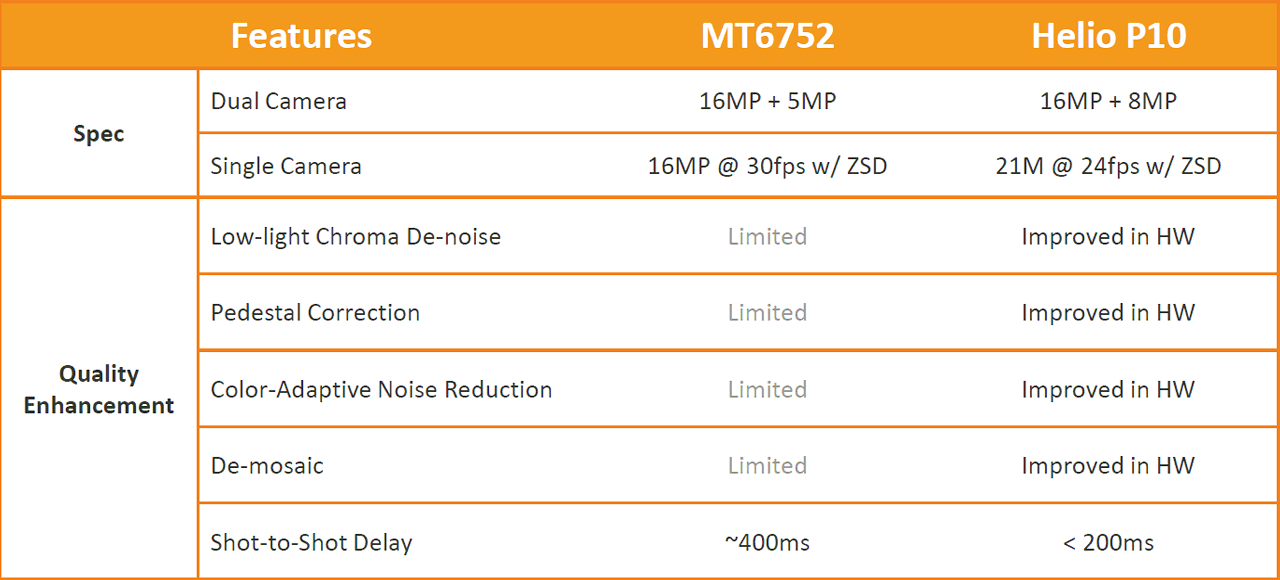
At first glance, the difference in the performance and functionality of processing information from camera modules between Helio P10 and MT6752 is small, but there are still some improvements. Firstly, the growing popularity of selfie shots justifies supporting the second 8-megapixel camera, compared to the 5-megapixel in the previous generation solution. Secondly, support for obtaining information from 21-megapixel sensors with a frame rate of 24 FPS may be in demand in some cases - in addition to the usual 16 megapixels at 30 FPS.
More than a twofold decrease in the delay between successive shots will be even more noticeable - this time has been reduced from 400 ms to less than 200 ms. Well, and even more important is the increase in the quality of numerous algorithms for processing information from sensors: the demosaic algorithm (de-buyerization - converting data received from the sensor), adaptive noise reduction, contextual adjustment of the signal level, noise removal when shooting in low light conditions, etc.
All this is also in the MT6752 system-on-chip, but in a very limited form. And in the new Helio P10 chip, all these hardware capabilities have been seriously improved, and now we will consider the most important of them with examples. Thus, the new adaptive noise reduction system provides smoother images with lower noise levels while maintaining maximum detail. The adaptive principle of information processing allows you to preserve the original colors as best as possible.

The above example shows that the new fourth-generation noise reduction system, designated as NR 4.0 , provides a lower noise level while maintaining almost the same detail and color information compared to the previous NR 3.0 algorithm. It may seem to some that the image is too “blurred” and lost in sharpness - but otherwise, you have to choose between detail and noise.
To improve the quality of photo and video shooting in low light conditions, MediaTek engineers have developed new algorithms to suppress color noise and adjust the signal level depending on the context, also adaptive. Here is an example of the noise reduction engine working in real time (first the frame without processing, then the result of the new algorithm):
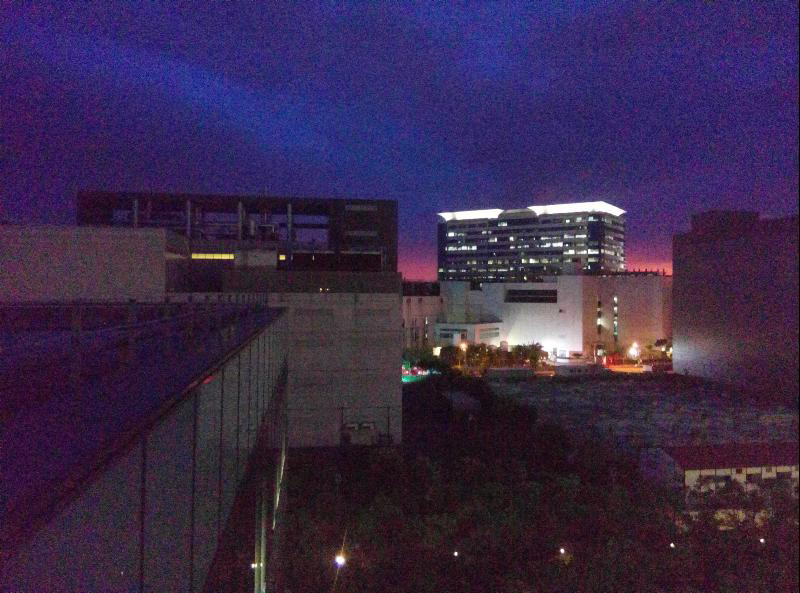

As a result of image processing, a clear reduction in the amount of color noise is provided, as well as adaptive changes in the signal level in some areas of the image, mainly dark objects. Well, another example that we will consider is the work of the new demosics (debyerization) algorithm, which converts the "raw" data received from the camera’s sensitive sensor into the form familiar to us.
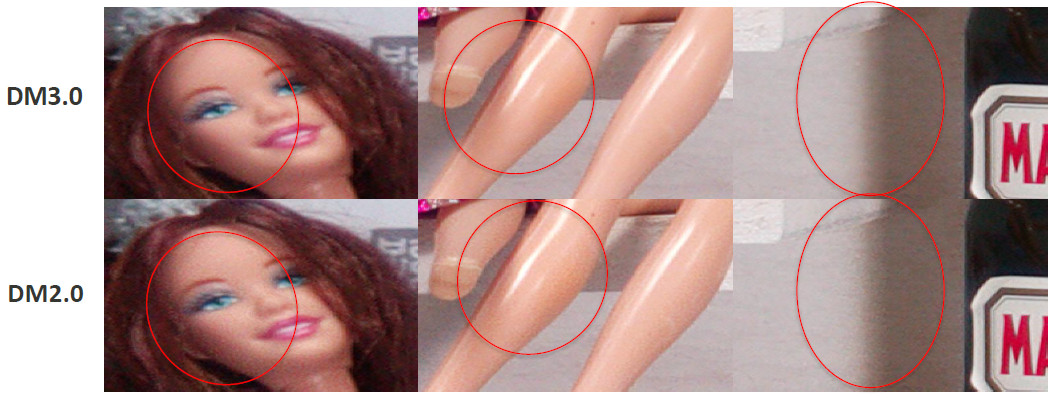
The third generation of the demosaic is indicated by the example as DM 3.0 , and compared with the previous version of DM 2.0, it provides more accurate color reproduction, improved processing of smooth color transitions, as well as better preservation of small details.
MediaTek has another interesting technology designed to improve the quality of photographs - ISO Adaptive Sharpness. This technology means a variable sharpening filter intensity for pictures taken at different sensitivities (ISO).
The problem with an unchanged sharpening level is that with an increase in the amount of noise, the use of such a filter only worsens the overall image quality, highlighting additional noise on it, since they have sharp transitions in intensity. And artifacts in the form of barely visible noise in the picture with an increase in ISO are exacerbated, because the noise level is further increased due to sharpening in these areas.
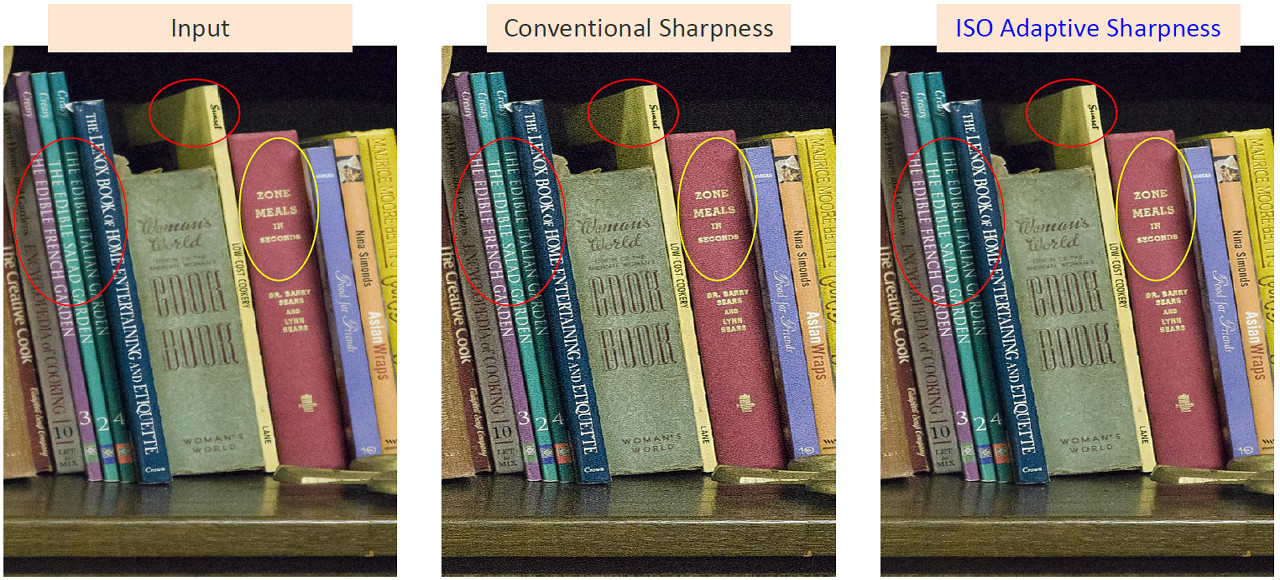
Look at an example - if the input image (on the left) is slightly blurred, then after the usual sharpening algorithm (in the center), it becomes sharper, but also too noisy in dark areas. As a solution to this problem, MediaTek offers an adaptive change in the intensity of the sharpen filter, depending on the ISO value and the content being filtered.
After applying the ISO Adaptive Sharpness algorithm, the picture is clear enough, but not too noisy. And this is especially important at extreme levels of sensitivity for compact "smartphone" sensors, such as ISO 1600 and 3200:
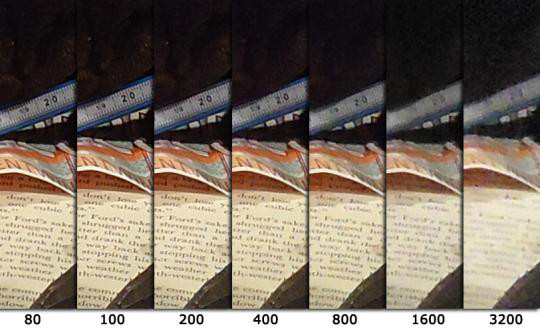
In general, although the changes in the support and processing system of visual data received from cameras in the new Helio P10 system-on-chip cannot be called revolutionary, they are sufficient so that the resulting pictures and videos compare favorably with moving and still images obtained on smartphones based on previous generation chips.
The Helio P10 system-on-chip supports the display of visual information on screens with resolutions up to FullHD (1920x1080 pixels) with a refresh rate of up to 60 frames per second. In this parameter, the new chip is no different from previous mass MediaTek solutions, and from competitors. Engineers of the company see the main difference in something else - in their technologies to improve image quality and reduce energy consumption.
MediaTek has a set of such technologies for improving image quality called MiraVision , and it already has version 2.0, which is also supported by the Helio P10 chip-based system. This kit includes the following technologies:
The proprietary technology in MiraVision is also responsible for automatically changing the brightness of the screen. The technology sets the brightness of the display based on lighting and taking into account the contents of the image displayed on the screen, its color palette and brightness. By analyzing the brightness and saturation of the picture, as well as the lighting conditions, MiraVision 2.0 technology adjusts the screen backlight to ensure its optimal level.
Curious BluLight Defender TechnologyDesigned to reduce the intensity of blue energy coming from the screen while maintaining acceptable color image quality. Such a filter is useful because some blue wavelengths can damage the eyes during prolonged exposure, and this is especially dangerous in the case of LCD screens. Therefore, manufacturers of devices and displays are trying to help protect the eyes of users by changing the color balance of screens by reducing the intensity of blue.
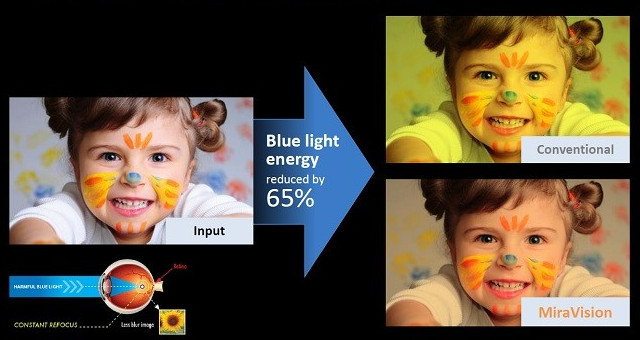
The company's specialists claim a reduction in blue energy by 65% with minimal changes in color rendering and virtually no loss of contrast. These improvements may not be so noticeable in normal use, but they improve comfort in certain conditions. The advantages of the MediaTek hardware solution are the absence of the need for additional software (applications like Blue Light Filter) along with lower power consumption, because the hardware unit consumes much less energy than a software filter that uses the graphics core.
Adaptive picture quality settings include several different technologies. Among them - Ultra Dimming, providing a minimum level of illumination from the screen - below the level that allows the settings of LCD displays. Look at a good example: when using hardware backlight reduction, a different level of brightness is provided (left and middle illustrations), but additional processing with the Helio P10 chip gives an even lower level of brightness (right):
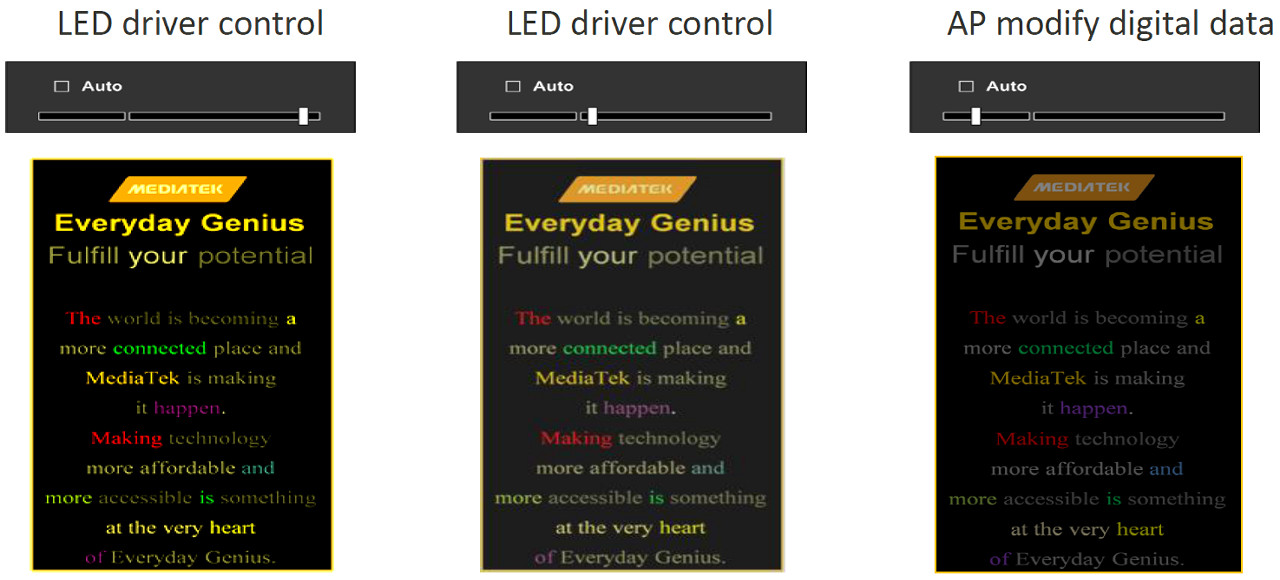
To achieve the desired result, the adaptive image change technology changes the original image displayed on screen, reducing the brightness level of its pixels. As a result of this technology, you can get a screen brightness of only 2 nt (nit is a unit of brightness) in the absence of any effect on performance.
Other adaptive image enhancement technologies include SmartScreen.- a technology that changes the data displayed on the screen depending on the task. For example, when previewing photos, it can display colors without changes, and when watching a movie, increase color saturation or adjust the brightness of various parts of the screen.

The use of SmartScreen technology allows you to get the perfect result in different lighting conditions: both in bright sunshine and in total darkness. The technology is able to evaluate the content of the displayed content and lighting conditions. Moreover, the brightness is adjusted separately for image areas, and not entirely - this processing is pixel-by-pixel. As a result, an image adaptively modified for specific conditions is displayed on the screen - with adjusted brightness, contrast and color saturation.
Almost all smartphone users use the device for its intended purpose at least once a day, talking on mobile communications. According to MediaTek, about 60% of users listen to music on their smartphones daily, 70% of the young users category make videos at least once a week, and more than half of all users regularly use the speakerphone function, outputting the interlocutor's sound to the smartphone speaker. All these tasks require high-quality processing and sound output, and users also want this. What can MediaTek have to offer them in the Helio P10?
In tasks from the entertainment sphere, the parameters of the built-in audio will be important - the new system-on-chip offers high-quality Hi-Fi sound using a high-quality digital-to-analog converter (DAC), which provides very good characteristics when outputting sound to headphones. In particular, a signal-to-noise ratio of 110 dB is claimed , and the harmonic distortion coefficient is 95 dB . Only top-end smartphones like Apple iPhone 6 have such parameters, and smartphones based on Helio P10 will be comparable in sound quality with the best representatives of the smartphone market.

In this diagram, the reference solution on a Helio P10 system-on-chip is compared with the best competitors: iPhone 5 and 6, ASUS PadPhone 2 (WCD9310 audio chip), Sony Xperia Z Ultra (WCD9320 audio chip), BBK XPlay and others. Judging by the company's data, the new system-on-chip provides the best performance among all solutions, surpassing its rivals in one or two quality indicators at once.
And so that users can enjoy the sound for as long as possible, Helio P10 uses a special low-power hardware unit to decode sound in the most popular MP3 format, allowing music to be played when the screen and data networks are turned off for more than 100 hours. The same applies to audio recordings, by the way - the unit also knows how to encode sound in MP3 with low energy consumption.
In addition to this system-on-chip, other proprietary technologies related to sound are also available: BesAudEnh - improving sound in headphones, BesLoudness - high-quality sound reproduction with high volume through built-in speakers, BesRecord- Improving low frequencies and expanding the stereo effect zone, MagiASR - high-quality voice recognition in noisy environments.
Several technologies are also used to increase user convenience during telephone conversations: MagiVoice and MagiConference - technologies for audio conferencing and other similar applications, MagiAEC and MagiNRDual - ensuring high-quality communication in hands-free mode, MagiClarity - noise reduction and improving sound clarity, MagiHDvoice - high-quality voice data transmission on mobile networks and others.
Summing up our note, it remains to note that Helio P10 is a very functional and productive on-chip system, which should become the basis for mass smartphones in the near future. The main question remains - when will this time come, and will the solutions based on the new system-on-chip from MediaTek go on sale? Judging by the information available, test samples of this chip are already available to manufacturers of mobile devices starting in September, and the appearance of ready-made solutions on the market is expected at the end of this or the beginning of next year.

The market segment targeted by the Helio P10 chip is much more massive compared to the high-budget solutions for which the Helio X20 was designed. If the X series is the top one for MediaTek, and provides the maximum performance and functionality corresponding to the upper price segment, the P series is also quite productive, but optimized to minimize the form factor and low power consumption, which allows you to produce thin smartphones with a capacious battery and good indicators of functionality and performance.
Such an energy-efficient solution allows you to provide longer smartphone life without recharging - for example, compared with the previous generation MT6752 system-on-chip, an average of 12% increase in operating time on a single charge is provided. And also reduces the likelihood of problems associated with overheating, but it becomes possible to use very thin cases for such smartphones, which is quite popular with manufacturers.

In addition, not all users want to pay the maximum price for a top-end smartphone, the capabilities of which they simply will not use. 10 computing cores in Helio X20 is very good, but not everyone needs it, the majority of users need 4-8 cores. The new Helio P10 chip just contains eight 64-bit ARM Cortex-A53 cores, which is quite logical for the solution of the upper-middle level. Moreover, these CPU cores operate at a frequency of 2 GHz , which ensures the maximum computational speed among solutions in this segment.
A top-end graphics core in a mass product is also not necessary at all, but the GPU must still be powerful enough, which is especially important now, when some of the calculations are beginning to be shifted, including to it. The new MediaTek system-on-chip uses the new ARM Mali-T860 video core operating at a frequency of 700 MHz, which in its functionality and performance is excellent for the mid-price range.
If we talk about specific numbers, then, compared to the system-on-chip MT6752, the use of the new GPU gives a performance increase of 20% while reducing the graphics core by 30%. The same applies to other tasks, including multimedia and related to the direct purpose of the smartphone - work with cellular networks. In general, the Helio P10 modem part provides about 20% less power consumption, and multimedia processing takes place with a quarter less power consumption. All this translates into longer battery life - one of the most important parameters for smartphones.
But even more important than the numerical characteristics are those technologies that really improve the comfort and functionality of smartphones for users. An example is support for the widest possible list of mobile communication standards, including advanced support for high-speed LTE networks. Or complex post-processing of images obtained using smartphone cameras, which can significantly improve the quality of images. This is already important for absolutely all users and is an indisputable advantage, even more important than the number of cores.
 Helio P10 is the first system-on-a-chip from the new Helio P line, which differs in that it combines a mid-range price and some characteristics of top-end solutions: high-speed data transfer on mobile networks, high quality sound and image. The Helio P10 model contains an integrated modem part that supports all the main LTE frequency ranges, LTE category 6 standard , carrier frequency aggregation according to the 2x20 MHz scheme, as well as data transfer rates up to 300/50 Mbit / s.
Helio P10 is the first system-on-a-chip from the new Helio P line, which differs in that it combines a mid-range price and some characteristics of top-end solutions: high-speed data transfer on mobile networks, high quality sound and image. The Helio P10 model contains an integrated modem part that supports all the main LTE frequency ranges, LTE category 6 standard , carrier frequency aggregation according to the 2x20 MHz scheme, as well as data transfer rates up to 300/50 Mbit / s. Like the older MediaTek chip-based systems, the P10 uses a load-sharing algorithm for the CorePilot computing cores, which allows you to use the capabilities of a heterogeneous architecture, distributing tasks among suitable computing units: universal CPU cores, a graphics core, or both at the same time.
The Helio P10 chip-based system also has rich multimedia capabilities, providing support for single 21-megapixel cameras or two 16-megapixel and 8-megapixel cameras, all with advanced demosaicing (debayerization) and noise reduction algorithms, improved shooting in low lighting, continuous focusing, support for HDR video and a short delay between shots, adaptive image quality improvement technology MiraVision, etc.
Helio P10 also features support for truly high-quality audio output with a declared signal-to-noise ratio of 110 dB and a non-linear distortion coefficient of 95 dB, which not every mobile solution can boast of, but extremely expensive smartphones from well-known companies: Apple, Samsung, Sony and others .
In general, it is safe to say that the Helio P10 brings some of the features of the high-end X series to mass products. Speaking conditionally, the new product differs from the previous mass MT6752 chip by an improved modem and a new graphics core, as well as reduced power consumption. And from the characteristics of the top X series, the new chip has computing cores operating at a frequency of 2 GHz, support for two high-resolution cameras with advanced post-processing, as well as the highest sound quality.

At the moment, the mass series of MediaTek is as if divided into two branches: advanced and inexpensive. If the MT6753 system-on-chip is a slightly improved MT6752 chip with support for Category 4 LTE networks, FullHD displays and a 16-megapixel camera, then Helio P10 already has more powerful CPUs and GPUs, 21-megapixel cameras and LTE mobile networks Category 6, with carrier aggregation and a maximum data transfer rate of 300 Mbps.
The most interesting thing is that with all this, the Helio P10 system-on-chip provides even slightly lower power consumption compared to the MT6752 chip of the same positioning from the previous generation!

As you can see from the numbers in the table, in the disconnected networks (Flight Mode), the new system-on-chip consumes 5% less energy, and when displaying the home screen and in the absence of active tasks, it is already 33%, which is quite a lot. Unfortunately, the table does not show individual figures for improving energy consumption in different tasks, but the average improvement in the energy consumption parameter is 25% for the modem part and 25-30% when processing multimedia data, including encoding and decoding of audio and video streams, as well as simple 2D games.
Specifications of the new product and comparison with its predecessors and competitors
In order to understand how big a jump in functionality and performance MediaTek has made with the release of the new system-on-chip, let's first look at the most important characteristics of the new chip and compare them first with the previous solution in the form of the popular MT6752 model:

As you can see, for The chip manufacturing process also uses the 28 nm process technology at the factories of the Taiwanese company TSMC, a semiconductor chip manufacturer. But the 28HPM process for Helio P10 is incorrectly indicated in the table, this chip is the first product of the company, which uses 28HPC + technology to reduce energy consumption.
TSMC claims to be able to get up to 15% more performance at the same level of consumption and a 30-50% reduction in leakage compared to 28HPC. Thanks to the use of an improved process technology, as well as architectural optimizations, the Helio P10 system-on-chip consumes up to 30% less energy compared to previous chips manufactured using the 28HPC technology.
As universal computing cores in Helio P10, the same eight Cortex-A53 cores are used as in MT6752, but they already operate at a frequency of 2.0 GHz, and not 1.7 GHz - this is another achievement of a more advanced technical process. The memory bandwidth was also improved - the operation of one channel of LPDDR3 memory with a capacity of up to 4 GB at a frequency of 933 MHz against 800 MHz and 3 GB, respectively, is supported.
In place of the ARM Mali-T760 MP2 graphics core operating at a frequency of 700 MHz, an improved ARM Mali-T860 MP2 video core with the same frequency characteristics came. The Mali-T860 can scale up to 16 cores, but in this case two cores contain four ALU execution units. So in terms of configuration, this GPU is identical to the Mali-T760, but it received several architectural improvements, which allowed to achieve some increase in performance compared to the previous solution.
The multimedia features of the new items have also been improved. Helio P10 has added support for 21-megapixel cameras with a processing frequency of 24 FPS in addition to supporting 16-megapixel cameras operating at 30 FPS. But even more important can be called the appearance of improved algorithms for hardware-based image processing: demosaics (debayerization), noise reduction systems and adaptive sharpening, which we will consider in more detail below.
The functionality of the new system-on-chip in terms of encoding and decoding video data has not changed; decoding of H.264 and H.265 video formats in 1080p resolution at a frame rate of 30 FPS is supported, as well as encoding to H.264 format with the same characteristics. But, thanks to architectural changes, in these tasks a reduction in energy consumption by a quarter was achieved. You can also highlight support for displaying information on displays with a resolution of 1920x1080 pixels and 12 layers of Blending Layer against 8 layers.
One of the most tangible improvements in the Helio P10 is the completely new modem part, supporting Category 6 LTE networks with carrier aggregation and a maximum data transfer rate of 300/50 Mbit / s versus just 4 category with 150/50 Mbit / s. The new chip also introduced support for CDMA2000 1x / EVDO Rev. networks. A (3.1 / 1.8Mbps, SRLTE), corresponding changes were made in the radio part.
Among other improvements, we note the support of data transmission over wireless networks of Wi-Fi standards 802.11 a / b / g / n with a transfer rate of up to 90 Mbps compared to the maximum speed of 78 Mbps of the previous model of the system-on-chip. Support for the operation of GPS, Glonass and Beidou global positioning systems has also been improved - in particular, the time to first fix (TTFF - Time To First Fix) has been reduced.
And what about competitors? Comparison with the previous system-on-chip from MediaTek is interesting, but the rest of the industry does not stand still, and the same company Qualcomm has released several solutions for the same market segment. Let's compare the Helio P10 with competing solutions: Snapdragon 425 (MSM8952) and Snapdragon 615 (MSM8939).

Firstly, Helio P10 is immediately distinguished by 28HPC + process technology (28HPM is again mistakenly indicated) against 28LP for Qualcomm system-on-chip. The advanced TSMC workflow allows for higher CPU and GPU frequencies, and hence their performance. Actually, this is also evident from the table - all three solutions have eight Cortex-A53 cores, but in the MediaTek system-on-chip they operate at a frequency of 2.0 GHz versus 1.5-1.7 GHz in the case of Snapdragon.
The same goes for GPUs. If the Adreno 405 video core as a part of the Snapdragon pair operates at a frequency of only 550 MHz, then the Helio P10 graphics in the form of a dual-core ARM Mali-T860 MP2 differ in operation at a higher frequency of 700 MHz. Of course, frequency is not the only indicator of GPU performance, but it is very important. And along with ARM architectural improvements in the new GPU core, it is MediaTek's solution that should provide the best speed.
Other distinguishing characteristics of the SoC under consideration include support for one camera with a resolution of up to 21 megapixels, albeit at a frequency of 24 FPS, versus 16 megapixels at 30 FPS. In addition, Helio P10 has a more powerful dual signal processor (ISP) that provides signal processing from a pair of cameras: 16 MP and 8 MP, in contrast to the dual ISP with support for two 8-megapixel cameras or even a single ISP in the case of Snapdragon 615.
The video output engine in P10 supports displays with a resolution of 1920x1080 pixels at 60 frames per second and 12 layers of mixing versus 4 layers from competitors. MediaTek considers it to be a very important advantage to support high-quality sound output with a signal to noise ratio of 110 dB and a non-linear distortion coefficient of 95 dB, in contrast to the signal-to-noise ratio of 96 dB in the case of integrated DACs in the integrated power management circuit (PMIC) for competing models Snapdragon
The remaining parameters for mass solutions from MediaTek and Qualcomm are approximately the same, and market success will depend on price and other characteristics, such as energy-efficiency systems-on-a-chip and third-party support for proprietary technologies of these companies. Well, since MediaTek's products are traditionally characterized by relatively low prices, the Helio P10 system-on-chip has every chance of gaining a considerable market share, and not only among Chinese smartphone manufacturers.
New camera features
We noted above that the work with cameras in the new Helio P10 system-on-chip has been improved, and now we will dwell on this in more detail. Firstly, the chip includes two powerful digital signal processing (ISP) processors that support sensors with resolutions up to 16 and 8 megapixels for the main and front cameras, respectively. The read and processing speed for the main camera can be 24 FPS for 21-megapixel sensors and 30 FPS for 16-megapixel.
Information from the main camera is processed by the TrueBright ISP signal processorthat supports highly sensitive sensors with an RWWB filter (Red, White, White, Blue - red, white, blue), and not just traditional RGBW. Such a color filter, in which the green pixel is replaced by white, helps to increase photosensitivity and improve the final quality of images. In the case of applying such a solution, the sensor will capture twice as much information about the light, and the detail and color information will remain the same.
At the same time, the so-called zero shutter delay ( Zero-Shutter Delay), due to which there will be practically no pauses between images. MediaTek’s state-of-the-art chip-based systems provide minimal latency - the pause between consecutive shots is less than 200 ms. There is also support for continuous autofocus, updated every frame, as well as support for laser and phase detection autofocus.

At first glance, the difference in the performance and functionality of processing information from camera modules between Helio P10 and MT6752 is small, but there are still some improvements. Firstly, the growing popularity of selfie shots justifies supporting the second 8-megapixel camera, compared to the 5-megapixel in the previous generation solution. Secondly, support for obtaining information from 21-megapixel sensors with a frame rate of 24 FPS may be in demand in some cases - in addition to the usual 16 megapixels at 30 FPS.
More than a twofold decrease in the delay between successive shots will be even more noticeable - this time has been reduced from 400 ms to less than 200 ms. Well, and even more important is the increase in the quality of numerous algorithms for processing information from sensors: the demosaic algorithm (de-buyerization - converting data received from the sensor), adaptive noise reduction, contextual adjustment of the signal level, noise removal when shooting in low light conditions, etc.
All this is also in the MT6752 system-on-chip, but in a very limited form. And in the new Helio P10 chip, all these hardware capabilities have been seriously improved, and now we will consider the most important of them with examples. Thus, the new adaptive noise reduction system provides smoother images with lower noise levels while maintaining maximum detail. The adaptive principle of information processing allows you to preserve the original colors as best as possible.

The above example shows that the new fourth-generation noise reduction system, designated as NR 4.0 , provides a lower noise level while maintaining almost the same detail and color information compared to the previous NR 3.0 algorithm. It may seem to some that the image is too “blurred” and lost in sharpness - but otherwise, you have to choose between detail and noise.
To improve the quality of photo and video shooting in low light conditions, MediaTek engineers have developed new algorithms to suppress color noise and adjust the signal level depending on the context, also adaptive. Here is an example of the noise reduction engine working in real time (first the frame without processing, then the result of the new algorithm):


As a result of image processing, a clear reduction in the amount of color noise is provided, as well as adaptive changes in the signal level in some areas of the image, mainly dark objects. Well, another example that we will consider is the work of the new demosics (debyerization) algorithm, which converts the "raw" data received from the camera’s sensitive sensor into the form familiar to us.

The third generation of the demosaic is indicated by the example as DM 3.0 , and compared with the previous version of DM 2.0, it provides more accurate color reproduction, improved processing of smooth color transitions, as well as better preservation of small details.
MediaTek has another interesting technology designed to improve the quality of photographs - ISO Adaptive Sharpness. This technology means a variable sharpening filter intensity for pictures taken at different sensitivities (ISO).
The problem with an unchanged sharpening level is that with an increase in the amount of noise, the use of such a filter only worsens the overall image quality, highlighting additional noise on it, since they have sharp transitions in intensity. And artifacts in the form of barely visible noise in the picture with an increase in ISO are exacerbated, because the noise level is further increased due to sharpening in these areas.

Look at an example - if the input image (on the left) is slightly blurred, then after the usual sharpening algorithm (in the center), it becomes sharper, but also too noisy in dark areas. As a solution to this problem, MediaTek offers an adaptive change in the intensity of the sharpen filter, depending on the ISO value and the content being filtered.
After applying the ISO Adaptive Sharpness algorithm, the picture is clear enough, but not too noisy. And this is especially important at extreme levels of sensitivity for compact "smartphone" sensors, such as ISO 1600 and 3200:

In general, although the changes in the support and processing system of visual data received from cameras in the new Helio P10 system-on-chip cannot be called revolutionary, they are sufficient so that the resulting pictures and videos compare favorably with moving and still images obtained on smartphones based on previous generation chips.
Display information
The Helio P10 system-on-chip supports the display of visual information on screens with resolutions up to FullHD (1920x1080 pixels) with a refresh rate of up to 60 frames per second. In this parameter, the new chip is no different from previous mass MediaTek solutions, and from competitors. Engineers of the company see the main difference in something else - in their technologies to improve image quality and reduce energy consumption.
MediaTek has a set of such technologies for improving image quality called MiraVision , and it already has version 2.0, which is also supported by the Helio P10 chip-based system. This kit includes the following technologies:
- Ultra Dimming - darken the screen to a minimum level for comfortable reading and viewing other content in low light conditions;
- BluLight Defender is a built-in blue filter that reduces the load on the eyesight and saves more energy than similar software solutions;
- Adaptive Picture Quality - adaptive adjustment of picture quality in various applications, providing realistic colors when previewing the result of photo and video shooting, and improving the brightness, contrast and color saturation when watching videos.
The proprietary technology in MiraVision is also responsible for automatically changing the brightness of the screen. The technology sets the brightness of the display based on lighting and taking into account the contents of the image displayed on the screen, its color palette and brightness. By analyzing the brightness and saturation of the picture, as well as the lighting conditions, MiraVision 2.0 technology adjusts the screen backlight to ensure its optimal level.
Curious BluLight Defender TechnologyDesigned to reduce the intensity of blue energy coming from the screen while maintaining acceptable color image quality. Such a filter is useful because some blue wavelengths can damage the eyes during prolonged exposure, and this is especially dangerous in the case of LCD screens. Therefore, manufacturers of devices and displays are trying to help protect the eyes of users by changing the color balance of screens by reducing the intensity of blue.

The company's specialists claim a reduction in blue energy by 65% with minimal changes in color rendering and virtually no loss of contrast. These improvements may not be so noticeable in normal use, but they improve comfort in certain conditions. The advantages of the MediaTek hardware solution are the absence of the need for additional software (applications like Blue Light Filter) along with lower power consumption, because the hardware unit consumes much less energy than a software filter that uses the graphics core.
Adaptive picture quality settings include several different technologies. Among them - Ultra Dimming, providing a minimum level of illumination from the screen - below the level that allows the settings of LCD displays. Look at a good example: when using hardware backlight reduction, a different level of brightness is provided (left and middle illustrations), but additional processing with the Helio P10 chip gives an even lower level of brightness (right):

To achieve the desired result, the adaptive image change technology changes the original image displayed on screen, reducing the brightness level of its pixels. As a result of this technology, you can get a screen brightness of only 2 nt (nit is a unit of brightness) in the absence of any effect on performance.
Other adaptive image enhancement technologies include SmartScreen.- a technology that changes the data displayed on the screen depending on the task. For example, when previewing photos, it can display colors without changes, and when watching a movie, increase color saturation or adjust the brightness of various parts of the screen.

The use of SmartScreen technology allows you to get the perfect result in different lighting conditions: both in bright sunshine and in total darkness. The technology is able to evaluate the content of the displayed content and lighting conditions. Moreover, the brightness is adjusted separately for image areas, and not entirely - this processing is pixel-by-pixel. As a result, an image adaptively modified for specific conditions is displayed on the screen - with adjusted brightness, contrast and color saturation.
Sound processing and output
Almost all smartphone users use the device for its intended purpose at least once a day, talking on mobile communications. According to MediaTek, about 60% of users listen to music on their smartphones daily, 70% of the young users category make videos at least once a week, and more than half of all users regularly use the speakerphone function, outputting the interlocutor's sound to the smartphone speaker. All these tasks require high-quality processing and sound output, and users also want this. What can MediaTek have to offer them in the Helio P10?
In tasks from the entertainment sphere, the parameters of the built-in audio will be important - the new system-on-chip offers high-quality Hi-Fi sound using a high-quality digital-to-analog converter (DAC), which provides very good characteristics when outputting sound to headphones. In particular, a signal-to-noise ratio of 110 dB is claimed , and the harmonic distortion coefficient is 95 dB . Only top-end smartphones like Apple iPhone 6 have such parameters, and smartphones based on Helio P10 will be comparable in sound quality with the best representatives of the smartphone market.

In this diagram, the reference solution on a Helio P10 system-on-chip is compared with the best competitors: iPhone 5 and 6, ASUS PadPhone 2 (WCD9310 audio chip), Sony Xperia Z Ultra (WCD9320 audio chip), BBK XPlay and others. Judging by the company's data, the new system-on-chip provides the best performance among all solutions, surpassing its rivals in one or two quality indicators at once.
And so that users can enjoy the sound for as long as possible, Helio P10 uses a special low-power hardware unit to decode sound in the most popular MP3 format, allowing music to be played when the screen and data networks are turned off for more than 100 hours. The same applies to audio recordings, by the way - the unit also knows how to encode sound in MP3 with low energy consumption.
In addition to this system-on-chip, other proprietary technologies related to sound are also available: BesAudEnh - improving sound in headphones, BesLoudness - high-quality sound reproduction with high volume through built-in speakers, BesRecord- Improving low frequencies and expanding the stereo effect zone, MagiASR - high-quality voice recognition in noisy environments.
Several technologies are also used to increase user convenience during telephone conversations: MagiVoice and MagiConference - technologies for audio conferencing and other similar applications, MagiAEC and MagiNRDual - ensuring high-quality communication in hands-free mode, MagiClarity - noise reduction and improving sound clarity, MagiHDvoice - high-quality voice data transmission on mobile networks and others.
Summing up our note, it remains to note that Helio P10 is a very functional and productive on-chip system, which should become the basis for mass smartphones in the near future. The main question remains - when will this time come, and will the solutions based on the new system-on-chip from MediaTek go on sale? Judging by the information available, test samples of this chip are already available to manufacturers of mobile devices starting in September, and the appearance of ready-made solutions on the market is expected at the end of this or the beginning of next year.
